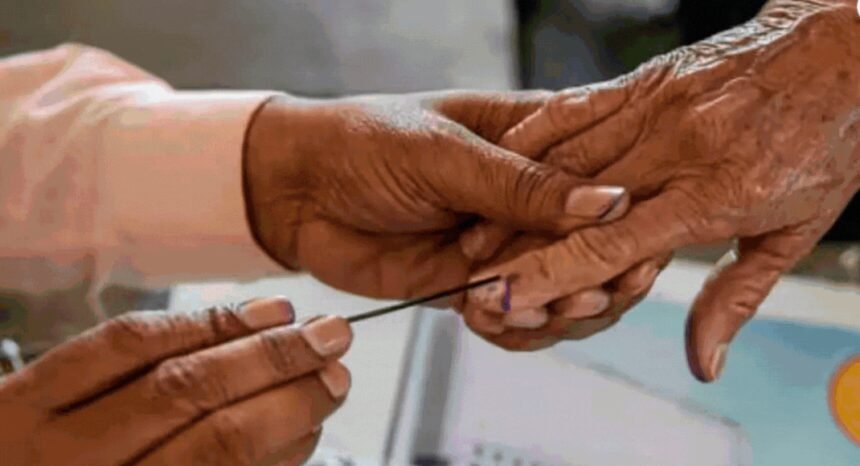However, the seats being contested in the 2024 elections are not exactly the same as those in the 2019 elections, but the differences led to a debate over the implications of low voter turnout.
In a move questioned by several opposition parties, the Election Commission updated the voter turnout percentage for phase 1 of the Lok Sabha election after 11 days and for phase 2 after 2 days.
With phase 1 polls completed on April 19 voter turnout data for phase 1 was released by a delay of 11 days on April 30, followed by phase 2 data on April 28, just two days after the phase 2 elections on April 26.
Opposition parties questioned the delayed update of turnout data. Congress president Mallikarjun Kharge wrote a letter to all parties, urging them to raise their voices against the Election Commission’s move.
In his ‘open letter’ to INDIA bloc leaders and other opposition leaders, Kharge highlighted the delay in releasing the final voting percentages for the initial phases of the Lok Sabha elections, suggesting that such delays cast doubts on the credibility of the data provided by the poll panel. He questioned the rationale behind the Election Commission’s delay in releasing the voter turnout data, which was made public 11 days after the first phase and four days after the second phase. Additionally, he sought clarification from the Commission regarding the reasons for the delay.
The Election Commission reacted sharply to Kharge’s allegations and accused him of creating impediments in the conduct of free and fair elections. The Commission said it finds a ‘pattern’ in a series of past and present irresponsible statements from Congress. Calling it ‘disconcerting’, the commission added that with all facts in place, the Congress President is attempting to push a biased narrative.
Following this, turnout data for subsequent phases was uploaded much faster.
What does difference in voter turnout suggest
Experts interpret the difference in voter turnout in various ways. Some suggest that low voter turnout could disadvantage the Bharatiya Janata Party, while others believe it might harm the Congress more.
The BJP, along with other opposition parties and the Congress, both claimed that the low voter turnout would be harmful. The BJP asserted that its voters were turning out at the booths. In fact, top BJP leaders, including Prime Minister Narendra Modi, passionately urged voters to cast their votes.
Some experts suggested that the BJP was heading for a huge win, causing its voters to become complacent. BJP leaders, including PM Modi, made several appeals requesting voters to come out and vote. They claimed that it was the opposition voters who were not showing up because they were sure of their defeat.
Voter turnout shifts: Insights and political impacts
The change in voter turnout percentage cannot be a definitive metric to judge election outcomes, but it often provides valuable insights. The shifts in voting percentages in key constituencies are always of significant interest. For instance, the Election Commission data shows substantial increases in voter turnout in several important constituencies: Jodhpur saw a 19.04% increase, Gandhinagar experienced a 19.38% rise, and Khunti reported a 17.9% increase. These changes suggest varying levels of voter engagement and potential shifts in political dynamics across these regions.
While some experts argue that a huge increase in voter turnout is a symbol for change, however that is not always the case.
Amethi: Minor turnout variations, major electoral shifts
Smriti Irani, who contested from Amethi against Rahul Gandhi in the 2014 elections, lost despite a significant campaign. The voting turnout percentage did not show much change despite the difference in the result. In 2014, the voter turnout percentage in Amethi was 52.38%, which was in favor of Rahul Gandhi. In 2019, it saw a marginal increase to 54.05%, which resulted in a victory for Smriti Irani. Now, in 2024, Amethi reported a voter turnout of 54.34%. These slight changes in voter turnout percentages reflect the evolving political dynamics in the constituency.
Despite these small changes in voter turnout, the constituency has seen varying electoral outcomes, highlighting that turnout percentages alone do not always predict the election results.
When examining the data, the difference in voter turnout between 2019 and 2024 is notably marginal. The average voter turnout in 2019 was 66.54%, compared to 65.54% in 2024 – both figures only till phase 6.
Many electoral experts have attributed this slight decline to various factors. A significant reason cited is the intense heat wave experienced during the 2024 elections. Additionally, the 2024 Lok Sabha elections were scheduled 15 days earlier than the 2019 elections, which may have also contributed to the lower turnout. These factors together have influenced voter participation, reflecting a complex interplay of environmental and logistical elements.
The nation eagerly awaits June 4, when the long-anticipated electoral results will be revealed, determining the fate of many candidates.
function loadGtagEvents(isGoogleCampaignActive) { if (!isGoogleCampaignActive) { return; } var id = document.getElementById('toi-plus-google-campaign'); if (id) { return; } (function(f, b, e, v, n, t, s) { t = b.createElement(e); t.async = !0; t.defer = !0; t.src = v; t.id = 'toi-plus-google-campaign'; s = b.getElementsByTagName(e)[0]; s.parentNode.insertBefore(t, s); })(f, b, e, 'https://www.googletagmanager.com/gtag/js?id=AW-877820074', n, t, s); };
function loadSurvicateJs(allowedSurvicateSections = []){ const section = window.location.pathname.split('/')[1] const isHomePageAllowed = window.location.pathname === '/' && allowedSurvicateSections.includes('homepage')
if(allowedSurvicateSections.includes(section) || isHomePageAllowed){ (function(w) { var s = document.createElement('script'); s.src="https://survey.survicate.com/workspaces/0be6ae9845d14a7c8ff08a7a00bd9b21/web_surveys.js"; s.async = true; var e = document.getElementsByTagName('script')[0]; e.parentNode.insertBefore(s, e); })(window); }
}
window.TimesApps = window.TimesApps || {};
var TimesApps = window.TimesApps;
TimesApps.toiPlusEvents = function(config) {
var isConfigAvailable = "toiplus_site_settings" in f && "isFBCampaignActive" in f.toiplus_site_settings && "isGoogleCampaignActive" in f.toiplus_site_settings;
var isPrimeUser = window.isPrime;
if (isConfigAvailable && !isPrimeUser) {
loadGtagEvents(f.toiplus_site_settings.isGoogleCampaignActive);
loadFBEvents(f.toiplus_site_settings.isFBCampaignActive);
loadSurvicateJs(f.toiplus_site_settings.allowedSurvicateSections);
} else {
var JarvisUrl="https://jarvis.indiatimes.com/v1/feeds/toi_plus/site_settings/643526e21443833f0c454615?db_env=published";
window.getFromClient(JarvisUrl, function(config){
if (config) {
loadGtagEvents(config?.isGoogleCampaignActive);
loadFBEvents(config?.isFBCampaignActive);
loadSurvicateJs(config?.allowedSurvicateSections);
}
})
}
};
})(
window,
document,
'script',
);
Source link




